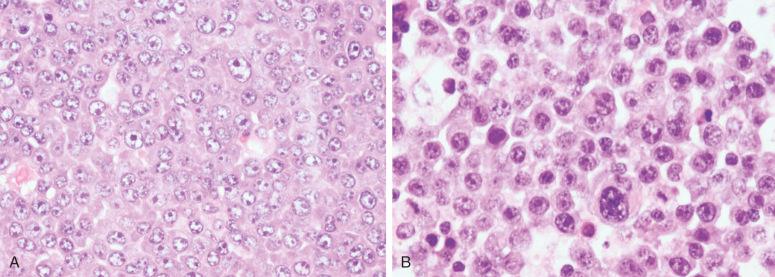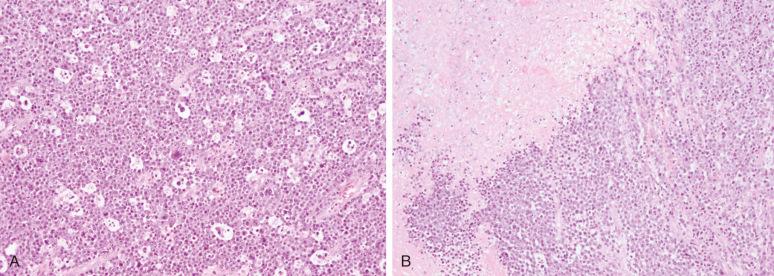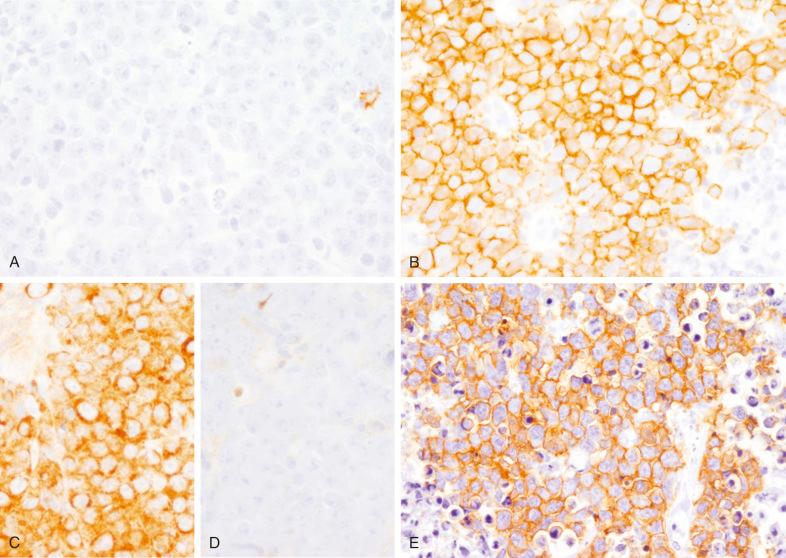Physical Address
304 North Cardinal St.
Dorchester Center, MA 02124
This chapter reviews two aggressive large B-cell lymphomas composed of large cells with a predominant immunoblastic or plasmablastic morphology and the immunophenotype of plasma cells. Despite sharing these morphologic and immunophenotypical features, one of them, plasmablastic lymphoma (PBL), occurs in patients with different types of immunodeficiency or advanced age, and most of them are related to Epstein-Barr virus (EBV). However, the second type occurs in immunocompetent patients, and it is caused by the activation of ALK by different translocations. The morphologic and immunophenotypical features of these lymphomas are also shared by HHV-8–related aggressive lymphomas, which are reviewed in Chapter 29 . The recognition of all these entities may raise differential diagnosis with other related tumors on both sides of the spectrum, such as diffuse large B-cell lymphomas and plasma cell neoplasms. The distinction is important because the clinical context and management of these patients may be different.
Plasmablastic lymphoma is a diffuse lymphoma composed of large B cells with a predominant morphology of immunoblasts or plasmablasts that express plasma cell differentiation antigens. Other subtypes of large B-cell lymphomas with a plasmablastic immunophenotype, such as ALK-positive large B-cell lymphomas and HHV-8–associated lymphoproliferative disorders, are not included in this category.
The term plasmablastic lymphoma (PBL) was introduced by Delecluse and colleagues in 1997 to describe a group of diffuse large B-cell lymphomas presenting in the oral cavity and jaws of HIV-infected individuals. These tumors showed immunoblastic morphology with an immunophenotype characteristic of plasma cells. Subsequently, PBL has been described in other localizations, mostly in gastrointestinal mucosa, and has been associated with other immunodeficiency states and advanced age.
This lymphoma occurs predominantly in adults with immunodeficiency and is most commonly caused by HIV infection, but it is also associated with iatrogenic immunosuppression (transplant and autoimmune diseases). Some cases arise in older adult patients without an apparent cause of immunodeficiency and in children with immunodeficiency, mainly HIV infection. HIV-positive patients tend to be younger than individuals with other types of immunosuppression.
The clinical presentation is frequently as a tumor mass in extranodal regions of the head and neck, in particular the oral cavity, and less frequently in the nasal cavity or respiratory sinuses. Other sites commonly involved are the gastrointestinal tract, soft tissues, skin, bone, lung, and, less frequently, the lymph nodes. Nodal presentation is more frequent in posttransplant-associated PBL (30%) than in HIV-infected patients or older adult patients (<10%). Computerized image exploration may detect disseminated bone lesions in 30% of patients. Paraprotein may be detected in some cases. Disseminated stage III/IV disease at presentation, including bone marrow involvement, occurs in 75% of HIV-positive patients and 50% of patients with posttransplant disease, but only in 25% of patients without apparent immunodeficiency.
The prognosis is generally poor, with more than three quarters of patients dying of the disease at a median interval of 6 to 7 months. Some reports observed patients with longer survival related to the new antiretroviral treatments, better immunologic status, and improvements in the supportive care and delivery of chemotherapy. However, these results are not consistent among studies. Evaluation of prognostic parameters have not yielded consistent results. However, the presence of the MYC translocation has been associated with poorer outcome in two studies.
Histologically, two variants have been recognized: monomorphic PBL and PBL with plasmacytic differentiation. Monomorphic PBL is composed of a diffuse and cohesive proliferation of immunoblasts or large cells with no or minimal morphologic plasma cell differentiation. Cases with plasmacytic differentiation have cells with rounder nuclei, coarse chromatin, eccentric nuclei, abundant basophilic cytoplasm, and paranuclear hof ( Fig. 25-1 ). Intermediate features between these monomorphic and plasmacytic variants may be seen in some cases. Monotypic maturing plasma cells may be occasionally present. A “starry sky” pattern is common in monomorphic cases with high mitotic activity and abundant apoptotic bodies. The border of the tumor infiltration is sometimes relatively well delimited, and areas of geographic necrosis are not uncommon ( Fig. 25-2 ).


The immunophenotype is similar to that of plasma cells with negative expression of CD45, CD20, and PAX5. A variable expression of CD79 may be seen in approximately 40% of the tumors. On the contrary, the tumor cells express plasma cell–associated markers and transcription factors such as CD38, CD138, VS38c, IRF4/MUM-1, BLIMP1, and XBP1 ( Fig. 25-3 ). Variable expression of cytoplasmic immunoglobulin may be seen. BCL2 and BCL6 expression is usually negative, whereas CD10 is expressed in 20% of the cases. Epithelial membrane antigen (EMA) is frequently expressed, and CD56 is detected in 25% of the cases. The tumors have a high proliferation (Ki-67) index (>90%). Reactive infiltrating T cells are usually very scarce.

Become a Clinical Tree membership for Full access and enjoy Unlimited articles
If you are a member. Log in here